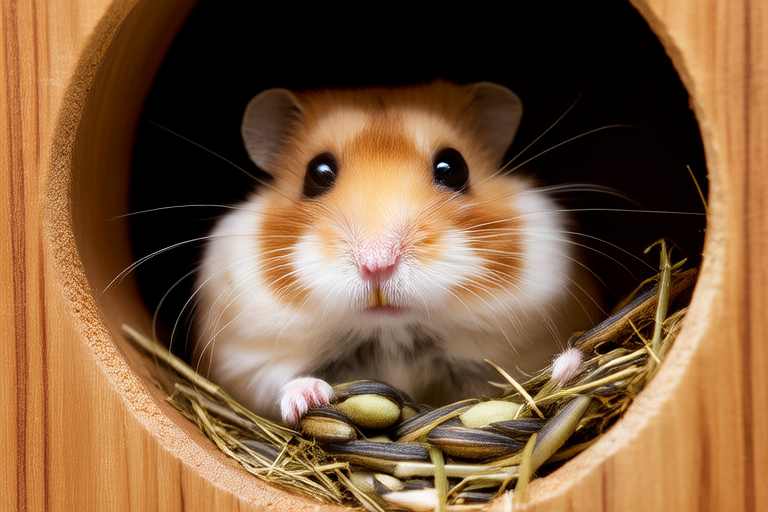Inside the Burrow: Understanding Your Golden Hamster’s World
Welcome to the fascinating world of golden hamsters! These small, furry creatures are popular pets for both first-time and seasoned animal lovers. Their charming personalities, combined with relatively low maintenance, make them ideal companions. However, to truly understand your golden hamster and provide the best care possible, it’s essential to delve into their natural habitat, behavior, and specific needs.
The Natural Habitat of Golden Hamsters
Golden hamsters, also known as Syrian hamsters, are native to the arid regions of Syria and Turkey. They thrive in semi-desert environments where they dig extensive burrows underground. These burrows serve multiple purposes: they protect the hamsters from predators, offer shelter during extreme weather conditions, and provide a safe space for raising their young.
In the wild, golden hamsters are solitary animals. They spend most of their time foraging for food, such as seeds, grains, and vegetation. Their natural habitat is characterized by sparse vegetation and rocky terrain, which shapes their behavior and instincts. Understanding this background can help you create an enriching environment for your pet at home.
Behavioral Insights
Golden hamsters are nocturnal creatures, meaning they are most active during the night. This behavior is a survival mechanism that helps them avoid daytime predators. In captivity, you might notice your hamster sleeping during the day and being more active after dark. It’s important to respect their natural rhythm and limit disturbances during their resting periods.
Hamsters are territorial by nature, so it’s crucial to house only one adult hamster per cage. Introducing two adult hamsters can lead to aggressive encounters, especially if they are not siblings raised together from a young age. Providing ample space and hiding spots within the cage can help reduce stress and promote a peaceful environment.
Setting Up the Perfect Living Environment
To ensure your golden hamster thrives, start by selecting an appropriate cage. A wire cage with a solid bottom or a spacious aquarium is recommended. The cage should be large enough to allow your hamster to move around freely and explore. A minimum size of 36 inches long, 18 inches wide, and 12 inches high is advisable.
Line the bottom of the cage with bedding material. Aspen shavings or paper-based bedding are good choices. Avoid cedar and pine shavings, as they can cause respiratory issues. Provide nesting material like soft cotton, tissue, or paper towels to encourage natural nesting behaviors.
Incorporate various toys and tunnels to stimulate your hamster’s natural instinct to burrow and explore. Cardboard boxes, tubes, and wooden chew toys can keep your pet entertained and mentally stimulated. Regularly rotate these items to prevent boredom and maintain interest.
Understanding Sleep Patterns
As nocturnal animals, golden hamsters require about 12 hours of sleep each day. During their waking hours, they engage in activities such as eating, exploring, and exercising. It’s important to respect their sleep schedule and minimize disturbances during their rest periods.
If your hamster seems excessively sleepy or lethargic during its usual waking hours, it could indicate an underlying health issue. Consult a veterinarian if you notice any unusual changes in your hamster’s behavior or physical condition.
Dietary Requirements
A balanced diet is crucial for maintaining your hamster’s health. Provide a mix of commercial hamster pellets, which contain the necessary nutrients, along with fresh vegetables and fruits. Good options include carrots, broccoli, spinach, and apples. Avoid feeding foods that are harmful to hamsters, such as citrus fruits, chocolate, and sugary treats.
Ensure a constant supply of fresh water. Use a sipper bottle designed for small animals to prevent spillage and contamination. Clean the bottle and replace the water daily to maintain hygiene.
Common Health Issues
Like all pets, golden hamsters can experience health problems. Some common issues include obesity, dental problems, and respiratory infections. Obesity can result from overfeeding or lack of exercise. Monitor your hamster’s weight and adjust its diet accordingly. Dental problems may occur due to improper chewing, leading to overgrown teeth. Provide plenty of chew toys to help maintain healthy teeth.
Respiratory infections can arise from poor ventilation or damp bedding. Keep the cage clean and dry, and ensure proper airflow. If you suspect your hamster has a respiratory infection, seek veterinary assistance immediately.
Enrichment Activities
To keep your hamster mentally and physically stimulated, incorporate enrichment activities into its routine. Hide treats throughout the cage to encourage foraging behavior. Rotate toys and introduce new ones periodically to maintain interest. Consider supervised playtime outside the cage under close supervision to allow exploration in a safe environment.
Training your hamster can also be an enjoyable activity. Start with simple tasks like teaching your hamster to come when called or to fetch a small object. Positive reinforcement techniques, such as offering treats and praise, can enhance the bonding experience between you and your pet.
Fostering a Deeper Connection
Building a strong bond with your golden hamster requires patience and consistency. Spend quality time with your pet every day, allowing it to get used to your presence and voice. Gradually introduce gentle handling and petting, respecting your hamster’s comfort level.
Pay attention to your hamster’s body language to understand its moods and preferences. Signs of contentment include relaxed posture, grooming, and sitting still. Conversely, signs of discomfort may include flattened ears, hunched posture, or biting. Always respond appropriately to your pet’s signals.
Conclusion
By understanding the natural habitat, behavior, and needs of golden hamsters, you can create a nurturing and stimulating environment for your pet. Providing a suitable living space, respecting their sleep patterns, offering a balanced diet, and addressing potential health issues will contribute to your hamster’s overall well-being. Incorporating enrichment activities and fostering a deeper connection through positive interactions will ensure a fulfilling relationship between you and your furry companion.
Welcome to the wonderful world of golden hamsters! With proper care and attention, your pet will bring joy and companionship to your life for years to come.
